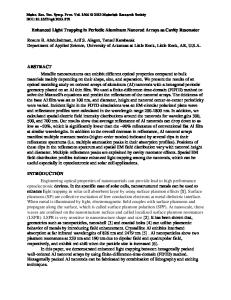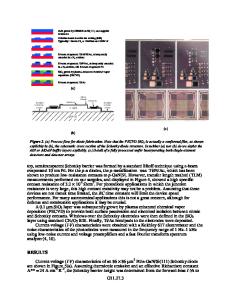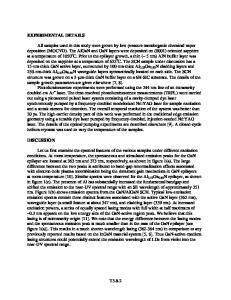Comparative analysis of light trapping GaN nanohole and nanorod arrays for UV detectors
- PDF / 1,683,437 Bytes
- 10 Pages / 547.087 x 737.008 pts Page_size
- 75 Downloads / 355 Views
RESEARCH PAPER
Comparative analysis of light trapping GaN nanohole and nanorod arrays for UV detectors Xingyue Zhangyang & Lei Liu Lu & Jian Tian
&
Zhisheng Lv & Feifei
Received: 9 March 2020 / Accepted: 3 August 2020 # Springer Nature B.V. 2020
Abstract In this paper, based on the excellent light trapping performance of the nanostructure, the structure of the electron emission layer of the ultraviolet detector is optimized. In this paper, simulation models of gallium nitride (GaN) nanohole arrays and nanorod arrays are designed by COMSOL Multiphysics software, which is based on the finite element method (FEM). In order to optimize the geometric parameters of GaN nanohole and nanorod arrays, and understand the influence of polarized light on them, the light absorption performance in the ultraviolet (UV) band has been fully analyzed. We found that when the lattice constant ranges from 200 to 500 nm, the GaN nanohole array and the GaN nanorod array have extreme absorptivity. And when the incident light has an inclination of 20°, the light trapping performance of the nanohole array can be further improved. GaN nanostructures with high light trapping capabilities will help improve the photoelectric emission efficiency of GaN photocathode and provide design reference for UV detectors with excellent performance.
Keywords GaN nanostructure . Photocathode . FEM . Light trapping . COMSOL multiphysics . Modeling and simulation X. Zhangyang : L. Liu (*) : Z. Lv : F. Lu : J. Tian Department of Optoelectronic Technology, School of Electronic and Optical Engineering, Nanjing University of Science and Technology, Nanjing 210094, China e-mail: [email protected]
Introduction In the solar radiant energy, the ultraviolet band accounts for about 7%, and the ozone layer has a strong absorption effect on the light in the 200–400 nm band. Ultraviolet detectors operating in the ultraviolet range have been greatly used in the context of detection. The image intensifier is a vacuum-type GaN ultraviolet detector and focuses on weak UV signal detection and imaging systems; it has the advantages of fast response, stable performance, low noise, and high gain. In recent years, there are many studies about the optical properties of various of nanostructures, such as nanowire (Garnett and Yang 2008, Garnett and Yang 2010, Cao et al. 2010, Fang et al. 2014, Li et al. 2015, Wu et al. 2017, Xu et al. 2017, Wang et al., 2017a, b), nanocone (Xu et al. 2016), nano-hemisphere (Kang and Fang 2014), truncated nanocone (Kim et al. 2018), pyramid (Tan et al. 2017), motheye (Makableh et al. 2018), nanohole (Han and Chen 2010, Peng et al. 2010, Adib et al. 2012, Fang et al. 2014, Chen et al. 2014, Hong et al. 2014, Wang et al. 2016, Wang et al. 2017a, 2017b, Deng et al. 2018, Fu et al. 2018), and nano-conehole (Du et al. 2011). The main materials of those nanostructures are silicon, silicon nitride, silicon carbide, gallium arsenide, or gallium nitride. GaN has a low electron affinity and stable physical and chemical properties, so it is widely use
Data Loading...











